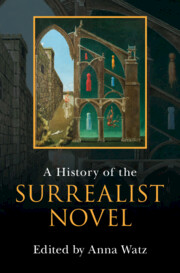Book contents
- A History of the Surrealist Novel
- A History of the Surrealist Novel
- Copyright page
- Dedication
- Contents
- Figures
- Contributors
- Acknowledgements
- Introduction
- I Marvellous Beginnings
- II Transgression and Excess
- Chapter 7 The Surrealist Novel and the Gothic
- Chapter 8 Surrealism’s Anti-Bildungsroman
- Chapter 9 The Mother Figure in the Surrealist Novel
- Chapter 10 British Surrealism at War
- Chapter 11 Surrealist Narratives of Trauma
- III Science, Alchemy, Nature
- IV Transnational Surrealism
- Index
Chapter 7 - The Surrealist Novel and the Gothic
from II - Transgression and Excess
Published online by Cambridge University Press: 02 February 2023
- A History of the Surrealist Novel
- A History of the Surrealist Novel
- Copyright page
- Dedication
- Contents
- Figures
- Contributors
- Acknowledgements
- Introduction
- I Marvellous Beginnings
- II Transgression and Excess
- Chapter 7 The Surrealist Novel and the Gothic
- Chapter 8 Surrealism’s Anti-Bildungsroman
- Chapter 9 The Mother Figure in the Surrealist Novel
- Chapter 10 British Surrealism at War
- Chapter 11 Surrealist Narratives of Trauma
- III Science, Alchemy, Nature
- IV Transnational Surrealism
- Index
Summary
Surrealism’s apparent hostility towards the novel was directed more towards the nineteenth-century realist tradition, whereas the movement was strongly attracted to the Gothic novel through its affinity with Romanticism and the celebration of the imagination. It looked back, too, to the pre-rational era of medievalism, celebrating motifs such as the castle, magic, and the supernatural, often framed within the literary device of the narrative journey of discovery, frequented by unnatural events and as exemplified in the writings of Ann Radcliffe and Matthew Lewis. This chapter finds its focus in the writings of three women: Ithell Colquhoun’s Goose of Hermogenes (1961), an alchemical-erotic journey of self-discovery; Valentine Penrose’s Erzsébet Báthory: La comtesse sanglante (1962), a poetic reinterpretation of a woman whose bloody career ended with her immurement in her own castle; and the poet Joyce Mansour’s Les gisants satisfaits (1958), a savagely erotic reworking of the trope of the persecuted woman. All three focus on the expression of the experience of the female body, with a particular emphasis upon the sensory in the work of Penrose and Mansour, while Colquhoun’s concern lies ultimately in spiritual development. All three refigure the model of the Gothic in post-war surrealist writing.
- Type
- Chapter
- Information
- A History of the Surrealist Novel , pp. 121 - 136Publisher: Cambridge University PressPrint publication year: 2023



